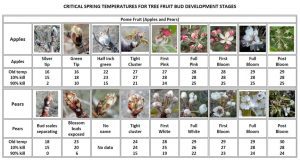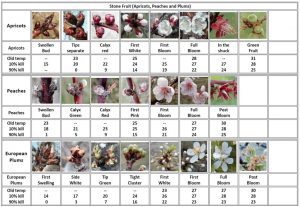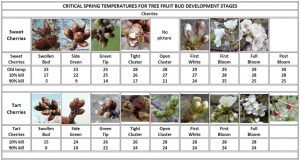Understanding Spring frosts: Critical Temperatures, Freeze Injury, and Frost Protection in Connecticut Fruit Orchards
Author: Evan Lentz, Assistant Extension Educator
Evan.Lentz@uconn.edu
Reviewers: Mary Concklin (Extension Educator Emeritus), Shuresh Ghimire (Associate Extension Educator)
Publication August 2023 | EXT080
https://doi.org/10.61899/ucext.v1.080.2024
Introduction
Late Spring frosts remain one of the most concerning and devastating weather events for fruit producers in the Northeast U.S. With a shifting climate and increasing weather instability, it is important to know what factors influence Spring frosts. Here, critical temperatures, freeze injury and frost protection are explored to help prepare for the future, keeping in mind that extreme weather events like this will likely continue to occur.
Critical Temperatures:
According to the USDA, ‘critical temperature’ is the highest temperature at which freeze/frost damage to plant tissues can be detected. These temperatures
allow an understanding of the relative cold tolerance of certain plant species. Below is a collection of critical temperature charts for various fruit crops, collected from various sources. Understanding this threshold for each of the crops grown will go a long way in developing risk management plans.
Tables 1-4 show the critical temperatures for various tree fruit crops, at various stages of development. Temperatures are organized by the temperature at which one can expect to see a 10% loss, and the temperature at which one can expect to see a 90% loss. Notice that the range in between these two values is often only a few degrees. Table 4 shows the critical temperature for various small fruit crops at various developmental stages. Some crops, such as brambles, blackberries and raspberries, have fewer differences in critical temperatures between the plant’s stages of development. Finally, Table 5 provides the same critical temperature information for grapes, with 10% and 90% kill estimates.
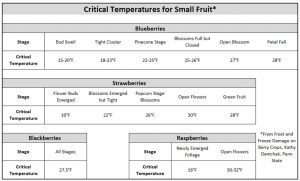
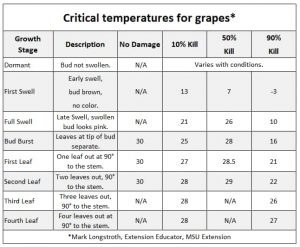
Something else to notice is that as the developmental stage progresses, the critical temperature increases. This means that as plants come out of dormancy and develop, they become more sensitive to cold temperatures. Often the opposite is assumed – thinking that the developing flowers are the most sensitive and that once past bloom, plants are in the clear. However, green developing fruit is highly susceptible to frost damage. Awareness of the critical temperatures for fruit crops will allow for more informed decisions in the frost protection plan. Additionally, these values are presented as estimates and it’s important to understand that other factors, such as genetics and other environmental factors, could affect a plant’s susceptibility to frost injury.
Common Frost Questions:
To best predict when a late season frost or freeze event may occur, understanding the dew point and how a frost occurs is important. Below are a couple of general questions about the dew point, frost formation, and freeze damage:
Q: What is the dewpoint and how does this affect frost formation?
A: The dewpoint is the absolute measure of the amount of water held in the air. The dewpoint is recorded as a temperature. When the air reaches that temperature, liquid dew is formed. When the dew point is below freezing, it becomes the frost point. When the air temperature reaches the frost point, a frost is formed.
Q: Different types of frost
A: There are two general types of frost. The first type of frost is called depositional frost, or white/hoar frost. This occurs when the dewpoint is below freezing (a frost point) and the air reaches or goes below that temperature. The water vapor goes directly from the gaseous state to a solid state, to form crystals on the surface of vegetation. The other type of frost is called a “frozen dew’ and occurs when the dewpoint is above freezing (not a frost point). The air temperature then reaches that dew point to cause a liquid dew to form on the surface of the vegetation and continues to fall below freezing. The liquid dew that was formed then freezes.
Q: Does frost need to occur to cause damage to vegetation?
A: Frost formation is not necessary to cause damage to vegetation. If the frost point (dewpoint) is well below freezing (say 20°F) and the nighttime air temperature reaches 23°F, no frost will be formed. However, when referring to critical temperature charts, it can be noted that 23°F is cold enough to cause damage to many fruit crops, despite their developmental stage. In fact, lower dewpoints (drier air) combined with below freezing temperatures work together to cause cold injury by both freezing and drying out plant tissues. This can occur to even fully dormant plant tissues and buds, with high winds acting to accelerate the process.
Factors Affecting Plant Tissue Hardiness:
One of the most common topics for discussion with growers this year has been cold-hardy varieties. Given the loss of peaches from the February cold snap and the late season freeze on May 18, many were wondering if more couldn’t be done to develop new cold-hardy fruit varieties, or if existing varieties could be evaluated for cold hardiness. This would make farm planning and varietal selection a bit easier considering these events are likely to continue to occur.

Selecting the proper varieties, whether it be for control of vigor, disease resistance or winter hardiness, is the first, and perhaps most important, step that can be taken to ensure optimal fruit production. However, studies have shown that environmental factors play a much larger role in cold hardiness/frost resistance when compared to the variety (or genetics) alone. For example, as much as two thirds of frost resistance in apple blossoms can be attributed to factors other than the plants variety (L. Szalay, et al. 2019). This other two-thirds includes things such as phenological stage, nutritive status, tissue moisture content, and late-winter/early-spring weather (Figure 1).
Many of these ‘other’ factors are still uncontrollable, such as the weather leading up to the frost event or the stage of development – which is tied directly to the preceding weather. Yet, there are some things that could be done to increase plants’ resilience. First, check to ensure that the plants have adequate water and nutrition going into dormancy. Practicing proper cultural management all season long ensures that plant tissues, and in particular flower buds, are not stressed or underdeveloped. Although this is not specifically preventing frost/freeze damage, it provides the plant with its best chance of enduring these late spring cold-weather events.
Preventative Measures:
Below are some frost protection ideas:
- Varietal Selection – pre-plant, passive protection
-
- Some varieties such as ‘Gala’ for apples are rated as cold tolerant.
- Site Selection – pre-plant, passive protection
-
- If possible, avoid sites that are overly exposed to winter winds. Winds work together with lower temperatures to dry out even fully dormant plant tissues;
-
- Avoid frost pockets or areas where cold air might gather and remain for extended periods of time.
- Good Cultural Management – passive protection
-
- Anything to reduce plant stress, water, nutrition, pest management.
- Wind Machines – active protection
-
- Works to bring the warmer rising air down towards the plants, preventing cold air from settling;
-
- Can be expensive.
- Heaters – active protection
-
- Warms the air around the plants.
- Helicopters – active protection
-
- Like wind machines, but more expensive.
- Overhead Irrigation – active protection
-
- Heat is released as the water freezes on the plants, keeping them at 32°F;
-
- Relies on a constant supply of water transforming into the solid state;
-
- Can be difficult to maintain coverage in windy conditions;
-
- The temperature at which to begin irrigation varies and is tied to the dewpoint. The lower the dewpoint, the earlier you want to start your sprinklers. If the dewpoint is in the teens, start irrigation at 38-39°F; if it is in the 20’s, start the irrigation at 34-37°F.
-
- Ensure the pressure is enough to fill any gaps in the sprinkler pattern;
-
- Do not stop the water until temperatures reach above freezing and the ice has begun to melt.
- Chemical Protection – active protection
-
- There are some chemicals which produce a hydrophobic particle film on the plant surface. However, these chemicals do not protect during bloom.
Assessing Freeze Damage:
While reviewing this information might allow for effectively assessing frost damage, Mark Longstroth of Michigan State University Extension provides a great overview. (https://www.canr.msu.edu/news/assessing_frost_and_freeze_damage_to_flowers_and_buds_of_fruit_trees )
Resources
DeHayes, D.H.; Williams, M.W., Jr. 1989. Critical temperature: A quantitative method of assessing cold tolerance. Gen. Tech. Rep. NE-134. Broomall, PA: U.S. Department of Agriculture, Forest Service, Northeastern Forest Experiment Station. 6 p.
Szalay, L.; Gyorgy, Z.; Toth, M. 2019. Frost hardiness of apple (Malus x domestica) flowers in different phenological stages. Scientia Horticulturae 253(309-315).
The information in this document is for educational purposes only. The recommendations contained are based on the best available knowledge at the time of publication. Any reference to commercial products, trade or brand names is for information only, and no endorsement or approval is intended. UConn Extension does not guarantee or warrant the standard of any product referenced or imply approval of the product to the exclusion of others which also may be available. The University of Connecticut, UConn Extension, College of Agriculture, Health and Natural Resources is an equal opportunity program provider and employer
